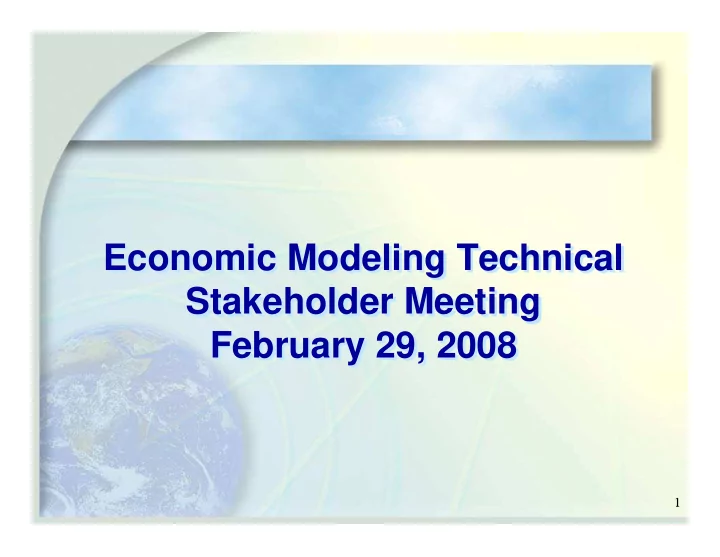

Economic Modeling Technical Economic Modeling Technical Stakeholder Meeting Stakeholder Meeting February 29, 2008 February 29, 2008 1
ENERGY 2020 Model ENERGY 2020 Model Inputs and Assumptions Book Inputs and Assumptions Book • The Inputs and Assumptions Book details the assumptions and data inputs that are used in the development of the Reference Case. • The Inputs and Assumptions Book should be viewed as a living document that will evolve as the model is reviewed and refined.
ENERGY 2020 Model ENERGY 2020 Model Inputs and Assumptions Book Inputs and Assumptions Book • Analytic Approach • Reference Case Inputs • Description of the Energy 2020 Model
Sources for Key Inputs for Sources for Key Inputs for Reference Case Reference Case Input Category California Rest of the West Population and Economic Census Census EDRAM EIA, BEA CA state sources Fuel Prices E3 for electric sector EIA EIA for other EIA State Energy Consumption, Price, and Energy Use and Consumption ARB GHG Inventory Expenditure Estimates (SEDS) Emissions and Air Regulations ARB GHG Inventory EPA Electricity Generation Capacity and EPA NEEDS database Operational (To be compared with WECC database used by E3)
Energy 2020 Energy 2020 ENERGY 2020 is an integrated multi-region, multi- sector energy analysis system that simulates the supply, demand and price for all fuels. • Dynamically describes the behavior of both energy suppliers and consumers for all fuels and for all end- uses. • Simulates the physical and economic flows of energy users and suppliers. • Simulates how energy users and suppliers make decisions and how those decisions causally translate to energy-use and emissions.
Energy Demand Energy Demand • Capital Formation – Energy is a derived demand • Fuel and Technology Market Shares – Represents fuel and efficiency level decisions • Stock and Flow Accounting – Capital and Energy Stock by Vintage • Energy requirements converted into energy demand – Utilization of Capital and Energy Stock
Energy Demand Energy Demand Detailed model of sectors • Residential – 3 structure types • Commercial – 14 sub-sectors • Industrial – 39 sub-sectors • Transportation – passenger, freight & off-road End Uses • Specific to each sector • Separates “substitutable” loads (multiple fuel choices) from “non-substitutable” (electric only). • Transportation divided into 7 “modes” as well as by vehicle classes within passenger and freight.
Electricity Supply Electricity Supply • Functional Divisions – Distribution – Transmission – Marketing – Generation • Capacity Expansion – developed endogenously – committed capacity specified exogenously • Generation and Fuel Use • Electricity Prices • Emissions
Other Supplies Other Supplies • Oil production (6 sub-sectors including non-conventional) • Gas production • Coal Mining • Combined Heat & Power & Steam Production • Ethanol Production • Renewables • Extensive choice of fuel types (33 fuels/sources modeled)
Model Outputs- - Emissions Emissions Model Outputs Model Outputs- Emissions • Combustion – by fuel, end-use, and sector • Non-combustion - by economic activity • Non-energy - by economic activity SO 2 NO 2 N 2 O CO CO 2 CH 4 PMT PM2.5 PM5 PM10 VOC CF 4 C 2 F 6 SF 6 HFC
Model Outputs- -Electric Summary Electric Summary Model Outputs Model Outputs-Electric Summary Generation by Plant Type (GWh/year) Peak Loads (MW) Generation by Primary Fuel (GWh/year) Reserve Margin (%) Industrial Generation (GWh/year) Electric Prices (fixed $/MWh) Generating Capacity by Plant Type (MW) Wholesale Electricity Price (fixed $/MWh) Generating Capacity by Primary Fuel (MW) Generation Capacity for Comparison with EIA (MW) Industrial Generating Capacity (MW) Generation for Comparison with EIA (GWh) Energy Demands by Plant Type (TBtu/year) Renewable Generation by Plant Type Energy Demands by Primary Fuel Emergency Generation (GWh) (TBtu/year) Industrial Generation Energy Demand (TBtu) Wholesale price for Node – Summer (fixed $/MWh) Energy Sales (GWh/year) Wholesale price for Node – Winter (fixed $/MWh) Transmission Flows (GWh/year)
Model Output- -Economic Drivers Economic Drivers Model Output Model Output-Economic Drivers Gross Regional Product (Billions of $/year) Personal Income (Billions of $/year) Population (Millions) World Oil Price (fixed $/mmBtu) Natural Gas Wellhead Price ($/mmBtu) Households (Thousands) Personal Income per person ($/person) People per household Distance Travelled (millions VMT) Distance Travelled (Miles/Person)
Model Output- -End Use Summary End Use Summary Model Output Model Output-End Use Summary Energy Demand (TBtu/Year) Marginal Device Efficiency (Btu/Btu) Average Device Efficiency (Btu/Btu) Process Efficiency ($/TBtu) Lifestyle Multiplier (Btu/Btu) Capacity Utilization Factor ($/Yr/$/Yr)
Model Output- -Transportation Technology Transportation Technology Model Output Model Output-Transportation Technology Passenger Total Energy Demand (tBtu/year) Freight Total Energy Demand (tBtu/year) Off Road Total Energy Demand (tBtu/year) Passenger Device Efficiency (Mile/mmBtu) Freight Device Efficiency (Mile/mmBtu) Off Road Device Efficiency (Mile/mmBtu) Passenger Average Device Efficiency (Mile/mmBtu) Freight Average Device Efficiency (Mile/mmBtu) Off Road Average Device Efficiency (Mile/mmBtu) Passenger Process Energy Requirements (million miles per year) Freight Process Energy Requirements (million miles per year) Off Road Process Energy Requirements (million miles per year)
Model Output- - Prices Prices Model Output Model Output- Prices Average Price of Electricity ($ /MWh) by Transmission, Distribution, Marketer and Total Average prices for other energy forms by sector ($/mmBtu)
Energy 2020 Energy 2020 Energy 2020 Reference Case for California Reference Case for California Reference Case for California E-DRAM EPA NEEDS Electricity Economic Data (e.g., Generation Capacity and GDP, Personal Operational Data Energy 2020 Income) Reference Case (Energy Use and Energy Use and Fuel Prices Emissions Tied to Emissions E3 for Electricity Economic Activity) CEC and ARB GHG EIA and CA sources for Inventory other prices Other Inputs Various CA and US Sources Data for other Western States are from EIA, BEA and USEPA
Policy Analysis Policy Analysis Policy Analysis Energy Prices ENERGY 2020 E-DRAM Sector Investment Allowance Revenue Energy Sector Policies Non-energy Sector Policies • Electricity • Forestry • Natural Gas • Agriculture • Transportation • Other • Oil & Gas/Refining Sector Output Personal Income CPUC/E3 Electricity Sector Policy Recommendations All policy runs are compared to the established BAU case
Recommend
More recommend